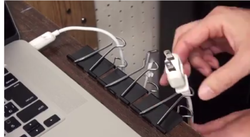
Before my 19 year old daughter headed for semester of college abroad, we headed to the local mall to shop for clothes that ensured she was suitably fashionable. (Me? I would have just thrown my most comfortable jeans, tees, and sneakers in a backpack and headed for the airport. But teenage girls? Well, you know.) So there we were milling around in Urban Outfitters, in what is probably a common (if slightly pathetic?) twosome: A father, trying to find a quiet corner or pillar to lean against until he is called upon for his credit card -- and his daughter, methodically moving from rack to rack, rapidly ruling items "in" or "out" based on some highly specific, but impossible-to-articulate criteria.
As I sat dad-like, on an out-of-the way platform near the front window, my eyes wandered and, per usual, began to focus on the minute details that make up an environment. What is it that makes an Urban Outfitters store feel like an Urban Outfitters? (Spoiler alert: A deep dive into the intricacies of retail space design is not where I'm heading with this particular post.) The pre-worn and pre-torn jeans, frilly tops, and crafted accessories are critical to the picture, to be sure. Then, there's enormously current alternative music, which -- though, piped throughout the store -- somehow appears to be provide the sensation of individual soundtracks for each teen's and 20-something's shopping experience. My daughter included. Next, you have to credit the invariably attractive, inked and/or pierced, and seemingly gender-fluid sales associates bustling about, tidying up the inventory, and facilitating checkouts. And, finally, there are the hardwood floors, exposed pipes and air-ducts in the ceiling, and the steam-punk inspired clothing racks themselves...all of these accents of environmental design meticulously chosen to foment the feeling you have discovered a genuine stash of edgy fashions in the basement of some, industrial-era Manhattan basement instead of a recently sheet-rocked stall of decidedly sub-urban shopping mall. Putting aside the cynicism of that last observation (as a father, it is true, I sometimes despair!) -- let's focus instead, as I did that day, on those industrial-looking racks (aka: 'retail fixtures') for a moment. And ask this question: Who supplies the thousands of linear feet of iron piping, cases of castor wheels, and faux, Edison-era lighting fixtures to this and other Urban Outfitters across the U.S. (not to mention the hundreds of similarly vibe'd competitive chains like American Eagle, Aeropostale, Old Navy, et al)? Allowing for variations of the multi-tier supply chain involved in this sort of thing -- doubtless, corporate buyers, retail store designers, and retail fixture distributors all play a role -- somewhere at the back of the line the are actual foundries, metal-working shops, and other assorted manufacturers of the pipe, fittings, wheels, woodblock, and fixtures we as consumers have come to expect in today's hipster retail environments. Companies... > who used to produce their wares exclusively for construction applications; > who used to sell exclusively to industrial customers; > who used to sell only through industrial distributors; ...and all of whom, at some point, had nary a thought of selling their grimy, gritty, and above all functional industrial goods into retail settings simply because they look cool. Now, I have a suspicion that the fashion industry (or fixture designers and makers) approached the industrial folks on this one, rather than the inverse. Nevertheless, a new market for existing materials resulted from the exercise of looking at an age-old product through new lenses. For another dramatic example of this sort of stand-on-your-head, new-market-for-existing-products thinking -- check out this life-hacker video that whips through a handful of alternative ways to use an ordinary binder clip in an office environment. Sure, some of these are silly or impractical, but some of might yield legitimate, new revenue streams if the ideas were re-packaged and marketed the right way. (If I were a clip or other commodity office products manufacturer, I'd consider charging someone on staff with replicating the process captured in this video. Marching order: "What other ways can one use our product... 1, 2, 3: Go!" So, if you've got product at the mature phase of its life cycle, before writing it off, so to speak, you may want to consciously consider it from a new vantage point: There might be new life, and new sales, awaiting you in an entirely new market. Tell us what you think of this blog or sign up to receive future installments here. ; )
1 Comment
 Doug Smith, President Doug Smith, President Imagine you are a marketing executive tasked with introducing a new product. Your sales force will do the selling, and your team will support them with promotional communications. You know your advertising agency will jump in when you call and you need to control the costs. There are four methods available to you for budgeting promotional expenditures: the percentage of sales method, affordable method, competitive parity method and objective/task method. The percentage of sales method allocates marketing expenditures based on past or anticipated sales. Using this method, you will be required to forecast sales to set the budget and limit the tasks you undertake to keep costs in line. The affordable method allows a company to invest what it can afford toward advertising. You can use the P&L to set the budget and limit the tasks you undertake to keep costs inline. The competitive parity method attempts to match spending to competitors’ budgets. If your competitors are large companies and you’re smaller, this option is expensive. The major weakness in all three of the budget methods above is that they fail to clearly define: “What is IT that you want to have happen?” In other words, how much will “it” cost, depends on what "it" is. The objective/task method of budgeting starts by defining objectives and allocating promotional expenditures based on what tasks are necessary to meet the objectives. This method is superior to all other budgeting methods because rather than eliminate tasks to control expenditures, it eliminates objectives if the budget is not available. While the objective/task method can be combined with the percentage of sales method or the affordable method to define total dollars available, the cost control variables are reversed and the focus is on planning for success. The process starts by prioritizing objectives based on a strategy and measuring the results to ensure objectives are achieved according to plan. Here’s an example wherein a railway equipment company and client of ours used the objective/task method to develop a plan to introduce a better product for stopping trains. Objective #1 – Install and field test the product on 100 cars. Tasks: Develop adequate promotional materials to launch the product internally and incentivize the sales team to introduce the new product to a select group of customers. Objective #2 - Quickly penetrate the market for new rail cars. Tasks: With opinion leaders now using the new product, an SMS Rapid Rollout was undertaken with a goal of selling several thousand units. Objective #3 - Retrofit and upgrade 100,000 older railcars with the new product. increasing brand preference and revenue. Tasks: Ongoing campaign to build awareness of benefits with railcar owners and generate inquiries and sales. A campaign strategy with clear and achievable objectives is the key to effectively using the objective/task budget method and will help you give direction to your advertising agency so they can help develop a plan. Once objectives are defined, your agency, working closely with product line managers and internal marketing staff, should be encouraged to look at a variety of different actions -- price each task -- and let each task or creative idea compete for dollars using judgement to prioritize the task options as well as develop a budget that is both affordable and adequate to achieve the objectives. When complete, an objective/task budget will allocate both the money and the time needed for success and answer these questions:
Once this is done, you can answer this question: "What is my investment going to do for my company?" En route, of course, your advertising agency is or should be an important partner in this process. Using history as a guide, your agency can price Videos, press releases, brochures, surveys, white papers, print or online ads, social initiatives, among many other tactics. Looking at the formidable challenge of budgeting your next project or even an entire year's worth of activities? Hopefully this has been helpful. And, of course, give a shout if you need some help (and a free consult focused on) defining what it is you want to have happen! [email protected] |
About MarketingMinds
Welcome to the official blog of Ithaca, NY-based Smith Marketing Services. Authored by members of the SMS team (we take turns or just chime in when inspiration strikes), MarketingMinds offers up Archives
March 2018
Categories |

 RSS Feed
RSS Feed